When Commenting on Childrens Art Experiences Your Focus Should Be on the Process
What is Process Art and why is it important?
Process Art is art that is child-directed, choice-driven, and celebrates the feel of discovery. In process art, the final product is ever unique and the focus lies in the creation of the work, not the outcome.
The greatest sign of success for a teacher…is to exist able to say, "The children are now working as if I did not exist." -Maria Montessori
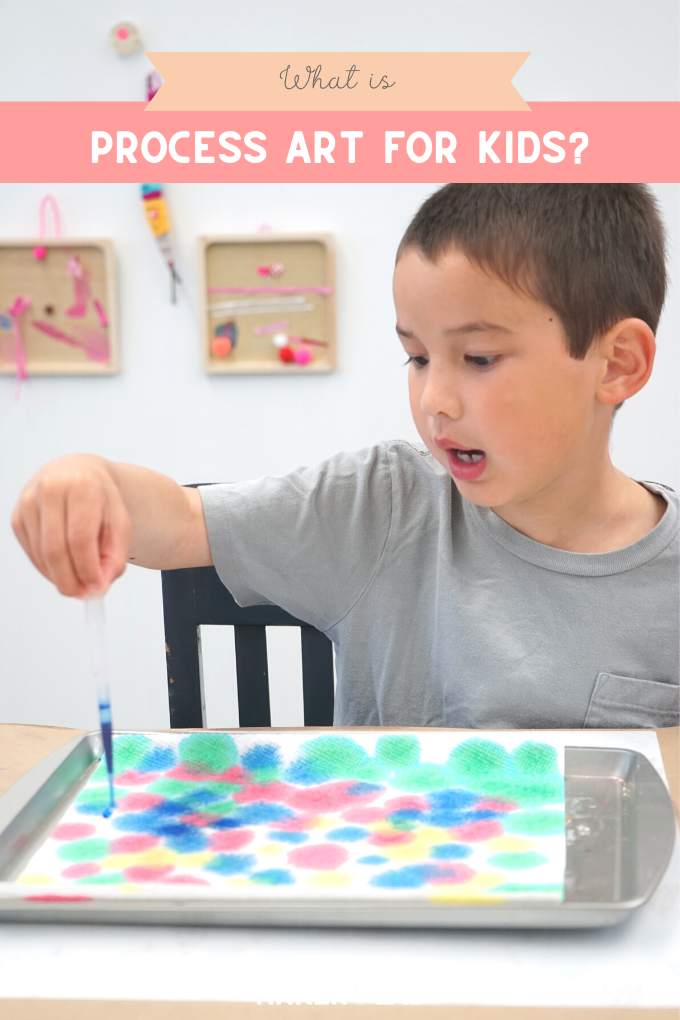
What are the benefits?
There are so many benefits to process art! Procedure fine art is developmentally advisable for toddlers, preschoolers, and immature children because information technology meets them where they are every bit sensory explorers.
Through process art, children…
- will have more opportunities for inventiveness, independence, and imagination
- will larn about the concrete limitations and possibilities of materials.
- are encouraged to use artistic and critical thinking skills.
- volition gain confidence to realize their own ideas.
- are motivated to ask questions and experiment.
- volition encompass experimentation and mistakes equally part of the learning procedure.
How this approach benefits adults
As much equally process fine art is age appropriate and engaging toddlers and preschoolers, parents and early on childhood educators generally find that it iseasier to facilitate than product-focussed art lessons because it aligns naturally with child development.
Hither are a few reasons why:
- Adults facilitate projects and act as co-learners, so they don't accept to concord all the answers. In fact, not knowing the answers can be a huge do good because it gives adults room to play and experiment themselves.
- Procedure-focussed projects don't require a lot of fancy gear up or unique materials that are difficult to come by. This saves both fourth dimension and money.
- Considering the goal of process fine art is to explore and discover, rather than achieve perfection, adults are likewise emotionally free to support whatsoever the child dreams up equally an ideal solution or end issue. No fighting, tears, or one-half-completed projects.
Is this the all-time approach for preschool fine art?
After reading up on all these amazing benefits are you still wondering if process fine art is the best way to teach art to toddlers, preschoolers, and kids?
There are plenty of proficient reasons to introduce kids to crafts projects, namely connecting to history and culture, developing manus-eye coordination, learning skills like paper folding, and bonding with family members or friends over craft traditions.
Crafts have their place and I happen to beloved them, even for kids. Simply when it comes down to helping children think like artists and inventors, procedure art, rich with open ended explorations that follow the child'south interests, is e'er the way to go.
How to Get Started with Process Art
- Offer self-serve supplies that the child can easily use independently
- Allow children to come and go as they please
- Provide interesting art materials
- Allow the child to follow his or her interests
- Keep the focus on open-ended activities that don't accept only one outcome
- Exist playful and joyful in the art-making process
- Inquire open-ended questions and brand objective comments nigh the child'southward artwork
What is the difference between process and production fine art?
Sometimes I'll hear people talk nigh procedure art versus product art equally if they're opposing ideas. In some sense they are, and I'll explain what that'southward about in a moment. First, still, I'd like to dispel a myth that procedure and product can't work together, when in fact they tin!
When people pit process against product, they're generally referring to how children make art. Process art's goals relate to what happens during the fine art sessions, while product art'southward goals chronicle to the final upshot.
Something I'd like you to go along in heed with all of this is that we shouldn't think virtually procedure and product every bit polar opposites because product is almost always embedded in process. When a child goes through the process of making a work of art, information technology's likely that he or she has an idea, question, curiosity, or even product in his or her mind. It may not be evident to us as viewers, but there's always an intention behind the procedure, and sometimes that intention connects to a concluding product.
This isn't actually what people are getting at, notwithstanding, when they talk most process versus production. The debate is really about the intention backside the fine art experience itself. Let's take a look at the breakdown in terms of how a process projection and a product project might look…
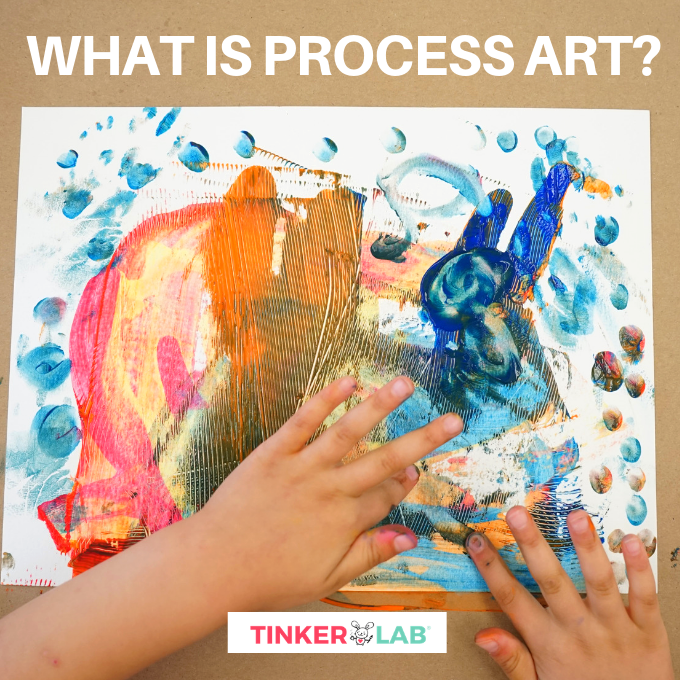
Process Art…
- is child-directed
- celebrates the feel of discovery
- has unique outcomes with no two pieces looking alike
- is open-ended with multiple avenues for discovery
Production Art…
- is developed driven
- offers the child clear steps that have to be followed
- expects the concluding product to look similar a sample
- what you might think of as crafts projects
- has expectations around a correct and wrong mode to do it

What materials are used in procedure art projects?
Any and all materials can be used in process art. It'southward less aboutwhat is used and more abouthowit'southward used, but I practice have a tip for assembling a successful process art prompt. Assemble supplies that fall into four different categories and you'll take something fabulous to play with: base, connector, tool, and treasure
The base of operations:newspaper, dirt, cardboard, or wood, cardboard rolls,
Connectors: gum, yarn, tape, slip (mushy wet clay)
Tools: a pencil, paint brush and paint, fork, sponges, crayon, skewer, markers, scissors
Treasures: foil, tissue newspaper, bubble wrap, chaplet, sequins
Example #1: clay, slip, skewer, chimera wrap
Example #2: cardboard, hot glue gun, tempera paint sticks, foil
ix Process Art Projects from TinkerLab
What is an example of process art?
Maybe information technology would help to meet this type of open up ended making really looks similar with toddlers, preschoolers, and kids? Let's have a look to see what ideas children have when given the opportunity to create with materials, with no production oriented expectation in mind.
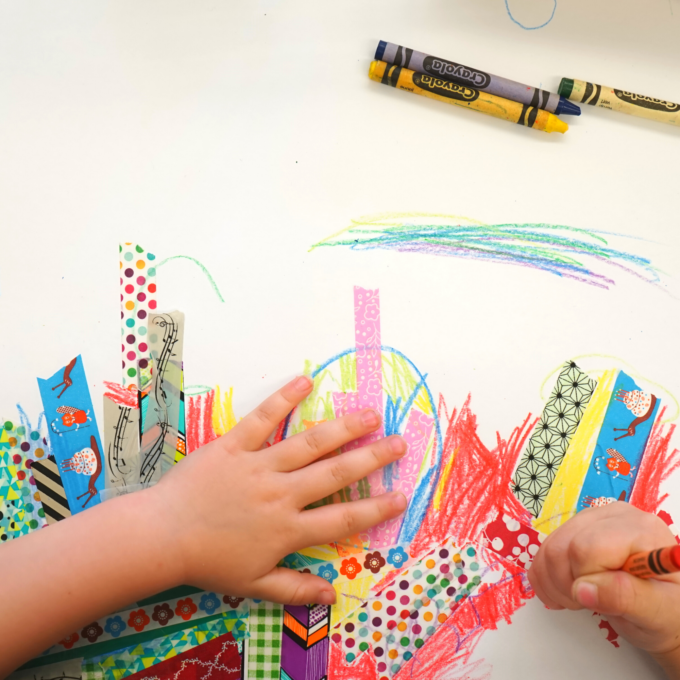
Large canvass of newspaper (base of operations) + washi record (connector and treasure) + crayons (tool)
This started as an invitation to create with a bundle of three crayons, connected together with a loop of washi tape. The child had no interest in drawing with a crayon packet, deconstructed it past removing the tape, asked for more tape, and fabricated this energetic composition with crayon and tape. Marvelous!
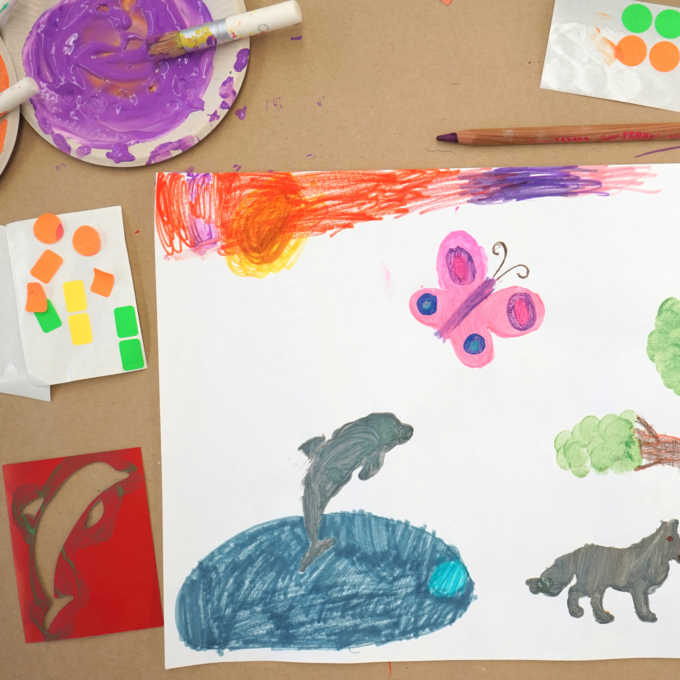
Paper (base) + stencil (tool)+ office stickers (connector and treasure)+ markers (tool)+ paint brushes with paint (tool) colored pencils (tool)
Although this is a semi-realistic illustration inspired by the stencil, the kid was not guided to exercise anything specific and this is the management they chose to take this in.
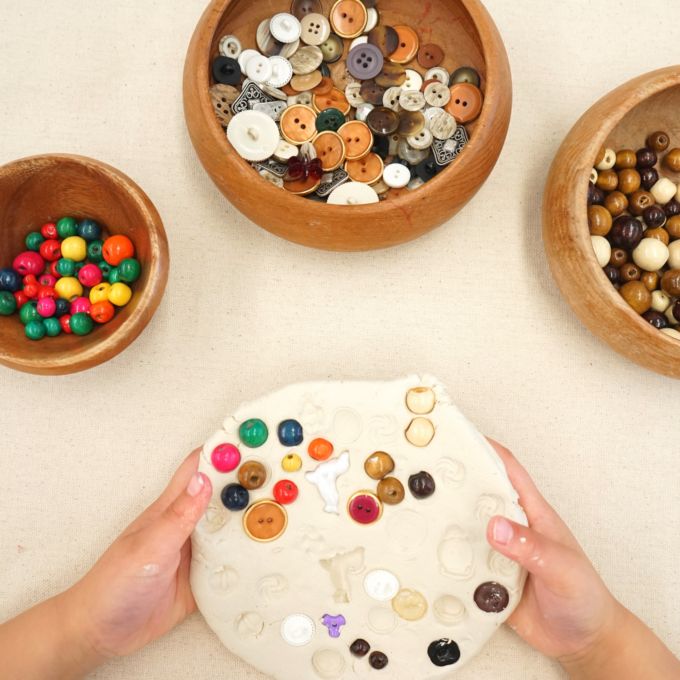
Dirt (base and connector) + Beads and Buttons (treasure and tool)
Notice how the chaplet double as a treasure and mark-making tool. The child decided to pull all the beads and buttons out when they were done, returning the clay to its original state. There was literally no product with this creation, as it all got returned to the art shelf when they were done.
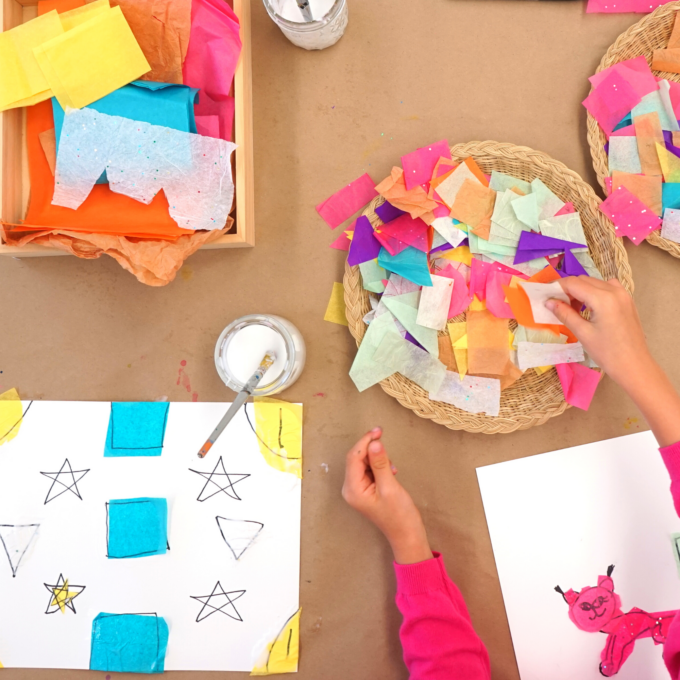
Heavy paper (base) + White mucilage and paint brush (connector) + Tissue newspaper (treasure), Mark (tool – off camera)
In this example, discover how two children used the same materials to create two entirely different outcomes. On the left, an organized blueprint with symmetrical balance. On the right, a whimsical fauna is taking shape.
If y'all're digging this topic, I wrote this fun piece for Americans for the Arts that I think you'll enjoy: Process over Product: Edifice Creative Thinkers Through Fine art.
Mutual Pitfalls with Process Fine art
There's non much you lot can practice incorrect with this kind of fine art making considering children lead the style once the materials are laid out. Yet, getting to that place where we but step back can be difficult for a lot of people. Hither are three things that tin cake a practiced process fine art experience:
- Don't stop your child to tell them what you lot think they should practise. Instead, just pause, take a deep breath, and requite your child room to continue making. You can ask them to tell you lot more about what they're doing. Usually this fiddling bit of information helps us encounter their intention, reminding us they're on the correct track.
- Don't doubt the procedure. Maybe you lot idea your child would utilise the materials one way, but they're doing something else, and you think: "This is not working. They're non learning annihilation. What'southward the indicate of all of this?" This is a totally normal reaction to process fine art. Instead, trust the process. If you're not sure where it's all leading, ask your kid to tell you more than near their ideas. I promise you'll be amazed at what they have to share.
- Have off your perfection lid. Cookie cutter projects are at present a affair of the past. Paper may exist cut at a crooked angle, white spaces may bear witness through quick paint strokes, and lines might be describe so faint that you tin can barely see them. What you lot run across in your child's work may not live upwards to your expectations, and instead please simply change your expectations. Observe the beauty of the wobbly lines, the personality of the paint strokes, and the energy backside the novice cut lines. Tell yourself how beautiful and charming it all is, and look for evidence of your child'south imagination, ideas, and curiosities.
How do you teach process art in early babyhood?
Employ the tips offered in this post and you'll be well on your way to leading meaningful process art experiences! If y'all could use a piffling more assistance, helping families and teachers find easy means to bring procedure art to life is my jam and I'd dear to welcome you lot into our tight knit community every bit a member of our subscription plan, TinkerLab Schoolhouse, where nosotros become deeper into process fine art and you'll proceeds access to a library of hundreds of playful prompts. You might too enjoy signing upwardly your trivial maker in a alive class in the TinkerLab Studio.
Favorite process art activities for kids
At present that you know more than about process art, let's swoop into some procedure art projects that you tin can try today:
Watercolor Paint on Doilies: Process Art with a Cute Result – ages iii and up
Collage with Leaves, Gum, and Cardboard – ages iii and upwardly
Sticking Tape to Paper Numberless – ages 2 and upward
Office Stickers inside a Drawn Frame – ages 2 and up
Cookie Canvas Monoprints with Tempera Pigment – ages 2 and upwardly
Shaving cream & food coloring – ages ii and up
cheongcheokhongtrandaste.blogspot.com
Source: https://tinkerlab.com/what-is-process-art-for-kids/